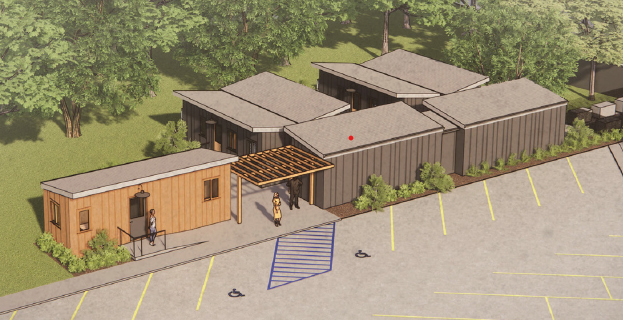Antioch Council learns about micro-housing program for city’s homeless residents

Architectural renderings by Shelterwerk of micro-homes planned for Hope Village at Grace Presbyterian Church in Walnut Creek. Source: Hope Solutions
Includes tiny homes and ADU’s
By Allen D. Payton
During their meeting Tuesday night, the Antioch City Council was provided a presentation on an effort to bring tiny homes to Antioch and the two-year Partnership for the Bay’s Future Breakthrough Grant to fund the effort to get them approved in the city. The proposal includes micro-home cottages on faith owned land plus Accessory Dwelling Units (ADU’s) on privately owned residential property.
The agencies are the Multi-Faith Action Coalition (formerly Contra Costa Interfaith Housing) and the Pleasant Hill-based Hope Solutions with help from the Local Initiative Support Corporation (LISC) Bay Area.
“Manufactured micro-homes are less costly than stick-built homes,” said Meredith Rupp, a Fellow with Partnership for the Bay’s Future.
They have identified 41 sites in Antioch totaling 75 acres. But regulatory changes are needed. They will work with Community Development Director Forrest Ebbs on that before bringing to the city council for consideration.
“Our preliminary vision is to develop a library of pre-approved plans…ready, off-the-shelf for homeowners to use,” said Jasmine Tarkoff, also of Hope Solutions.
A Resident Empowerment Program is the “third pillar” of the effort including mental health services and support for job training, and other “wrap-around” services, shared Deborah Carney, of Hope Solutions and an Antioch resident.
According to the Partnership for the Bay’s Future website, the Breakthrough Grants program is “to help communities pass equitable housing policy. Selected local governments will receive a dynamic, mission-driven fellow who will work on community-driven local policy in affordable housing production and preservation. The Partnership will also provide two years of grant funding to community partners to engage and activate the local community. The whole Breakthrough Grant cohort will have access to a flexible pool of funding for technical assistance to meet their policy goals. The value of this support is about $500,000 per jurisdiction.”

Examples of Accessory Dwelling Units (ADU’s). Source: Partnership for the Bay’s Future
Father Robert Rien of St. Ignatius Catholic Church in Antioch spoke in favor of the program. “I have seen homelessness right up front. We have had a very strong concern about those who are not as blessed us to have homes. One of the issues that has really burned for me are the number of families living out of their cars. The Antioch school district has 235 families living out of their vehicles. We have a number of veterans living along the river.”
His parish was instrumental in building Tabora Gardens Senior Apartments located on Tabora Drive at James Donlon Blvd.
“We have eight-and-a-half acres. We’d like to use part of our property to build housing for the unhoused. We’re hoping to build 21 units,” he added.
People affiliated with Hope Solutions and other organizations, as well as a few Antioch residents spoke in favor of the tiny homes, including Pastor Chris Watson of the Golden Hills Community Church Community Outreach Center (COC) on East 18th Street.
“The biggest area of need is affordable housing,” he said. “Our people have income. We’re trying to provide them dignity. Providing a roof over their head is a difficulty. We look forward to partnering together.”
Council Discussion
During council discussion of the item District 3 Councilwoman Lori Ogorchock wanted to know, “This is permanent housing?”
“Yes,” was the response.
“Who will be there, families?” she asked. “I would like to see it as a family unit, myself. Under the government entities the County isn’t listed. I’d like to see the County partner with us. They get money from the state.”
“I think it’s a great idea. I love the idea,” Ogorchock continued. “It’s an exciting project and I think it’s something doable within the city.”
District 2 Councilman Mike Barbanica, “When we say permanent housing are we talking forever, 30 years? And what is the funding mechanism beyond?”
“They’re built to HCD standards, the same as your home and my home,” Tarkoff explained. “These are not pallet homes or Tuff Sheds. This particular grant is all around being able to develop to explore micro-homes on faith owned home…streamlining the entitlement process.”
The organization is engaged in both public and private funding for the construction and ongoing costs.
“There is no plan in place to get that person into permanent housing?” Barbanica asked.
“The plan is to bring individuals and families, provide them with the housing, with support services…Hope Solutions does not place time limitations on how long an individual can stay in a home,” Tarkoff responded. “Of course, our goal is as individuals heal and want to get into larger housing, we’d like to get them into that trajectory.”
“On our end as policy makers we’ll really only be dealing with zoning,” Mayor Lamar Thorpe said. “This is your project. We don’t set expectations. We spend our time getting the zoning done. We’re not approving anything. We’re not. Just zoning. Certainly, we want to be involved.”
“I still believe in participating in this…proposal at the church,” Ogorchock added. “I think it’s more than just zoning and entitlements.”
“Our job is to not make this cumbersome. We can easily get in the way,” Thorpe stated. “You’re not asking for permission. Let’s create the zoning and let the churches and faith-based organizations get the job done.”
the attachments to this post:






















